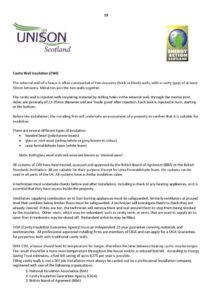
The external wall of a house is often constructed of two masonry (brick or block) walls, with a cavity (gap) of at least 50mm between. Metal ties join the two walls together.
The cavity wall is injected with insulating material by drilling holes in the external wall, through the mortar joint. Holes are generally of 22-25mm diameter and are ‘made good’ after injection. Each hole is injected in turn, starting at the bottom.
Before the installation, the installing firm will undertake an assessment of a property to confirm that it is suitable for insulation.
There are several different types of insulation:
- bonded bead (polystyrene beads)
- glass or rock wool (yellow/white or grey/brown in colour)
- urea formaldehyde foam (white foam)
Note: both glass wool and rock wool are known as ‘mineral wool’.
All systems of CWI have been tested, assessed and approved by the British Board of Agrément (BBA) or the British Standards Institution. All are suitable for their purpose. Except for Urea Formaldehyde foam, the systems can be used in all parts of the UK. All systems have a similar insulation value.
A technician must undertake checks before and after installation, including a check of any heating appliances, so it is essential that they have access inside the property.
Ventilators supplying combustion air to fuel burning appliances must be safeguarded. Similarly ventilators at ground level that ventilate below timber floors must be safeguarded. A technician will investigate them to check they are already sleeved. If they are not, the technician will remove them and seal around them to stop them being blocked by the insulation. Other vents, which may be redundant, such as cavity vents or vents that are used to supply air to open fires in bedrooms may be closed off. Redundant airbricks may be filled.
CIGA (Cavity Insulation Guarantee Agency) issue an independent 25 year guarantee covering materials and workmanship. All professional approved installing firms are members of CIGA and can apply for a CIGA Guarantee, for properties built with traditional cavity walls.
With CWI, a house should hold its temperature for longer, therefore the time between heating cycles may be longer. The result should be a more even temperature throughout the house and/or a reduced fuel bill. According to Energy Saving Trust estimates, a fuel bill saving of up to £275 per year is possible.
Filling cavity walls is not a DIY job. Installation must always be carried out by a professional installation company, registered with one of the following organisations:
- National Insulation Association (NIA)
2. Cavity Insulation Guarantee Agency (CIGA)
3. British Board of Agrement (BBA)
There are a number of grants and schemes available which may support the installation of cavity wall insulation.
In April 2017 a new scheme was launched by construction industry approvals body the British Board of Agrément (BBA) which will focus on reducing the risk of cavity wall insulation being improperly installed in homes. The Cavity Assessment Surveillance Scheme (CASS) checks the suitability of properties for upgrades, ensures assessments are structured and independent and confirms they are sent to the BBA. The BBA then checks the assessments to verify the correct procedures have been followed.
